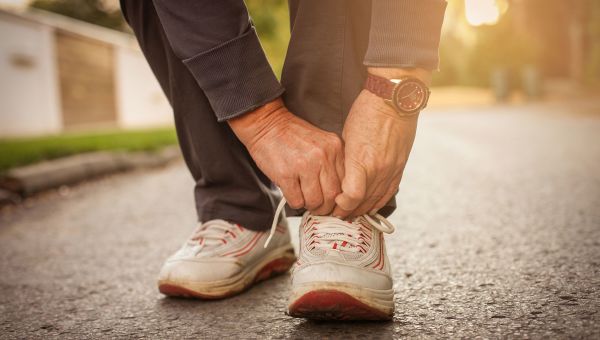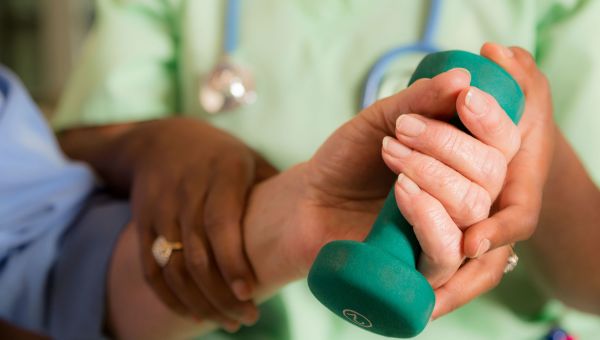The smart way to exercise after a heart attack
Staying physically active can be part of your recovery—and help to prevent another cardiac episode.

After a heart attack, many people are worried about returning to their regular activities and careers. They can be especially nervous to start an exercise routine again for fear it could trigger another heart episode. However, physical activity is often essential when recovering from a heart attack and helping to prevent another cardiac episode. The keys are to work… Show More
After a heart attack, many people are worried about returning to their regular activities and careers. They can be especially nervous to start an exercise routine again for fear it could trigger another heart episode. However, physical activity is often essential when recovering from a heart attack and helping to prevent another cardiac episode. The keys are to work closely with your medical team, start slowly and find activities that you love to do.
Show Less

Start with cardiac rehab
After leaving the hospital, it is recommended that many heart patients attend cardiac rehabilitation. “Anybody who has a heart attack or has coronary artery disease or who underwent angioplasty or stent placement are the ideal candidates for cardiac rehab,” says Waddah Salman, MD, Chief of… Show More
After leaving the hospital, it is recommended that many heart patients attend cardiac rehabilitation. “Anybody who has a heart attack or has coronary artery disease or who underwent angioplasty or stent placement are the ideal candidates for cardiac rehab,” says Waddah Salman, MD, Chief of Cardiology at Memorial Hospital in Jacksonville, Florida.
This medically-supervised outpatient treatment, usually consisting of up to 36 one-hour long sessions, focuses on exercise, lifestyle changes and mental health, all personalized to your health. A team of doctors and therapists can test a patient’s tolerance for low-impact exercises while keeping tabs on their blood pressure and heart rate and rhythm. It’s a great way for people to ease back into fitness and their everyday activities while learning their limits.
In addition to setting fitness goals, patients also learn how to change their diets, manage stress and adjust to a new medication routine. “The name might imply cardiac rehab is just exercise training but it's not. It's a comprehensive educational lifestyle modification program,” says Dr. Salman.
Show Less
Start adding aerobic exercise slowly
Patients are encouraged to be physically active while they complete cardiac rehab and to continue to exercise after their program is complete. “In cardiac rehab, patients start slowly and when they finish the program, they'll be able to do a good level of physical activity,” says Salman. “And they… Show More
Patients are encouraged to be physically active while they complete cardiac rehab and to continue to exercise after their program is complete. “In cardiac rehab, patients start slowly and when they finish the program, they'll be able to do a good level of physical activity,” says Salman. “And they know they're safe because they've been monitored.”
Staying active can help restore normal heart function after a heart attack. It can also reduce cholesterol, blood sugar and blood pressure, while helping to keep weight off—all important ways to help prevent a repeat cardiac event. Exercise also helps to ward off stress and symptoms of depression, which can affect many who suffer a heart attack.
Even so, it may take weeks or months to get back to the level of activity you had before your heart attack. Low impact activities, under the supervision of a medical team, are usually recommended to back ease into an exercise routine. Cardiac rehab patients should stay within their comfort zones while following exercise programs designed or approved by their doctor. The Sharecare app (available for iOS and Android) can make it easy to measure your progress through its steps tracker.
Salman also suggests that people recovering from a heart attack wear a heart rate monitor when exercising, staying under 70 to 75 percent of their maximum heart rate. A stress test is typically conducted at the beginning and end of a cardiac rehab program, so you can get a sense of what your maximum heart rate might be.
Show Less
Don’t be afraid to strength train
Once thought to be harmful to heart attack survivors, some doctors will now recommend resistance and strength training as an integral part of recovery if they feel their patients will benefit. The goal of resistance training is to get people strong enough to return to the tasks or jobs they did… Show More
Once thought to be harmful to heart attack survivors, some doctors will now recommend resistance and strength training as an integral part of recovery if they feel their patients will benefit. The goal of resistance training is to get people strong enough to return to the tasks or jobs they did prior to their heart attack.
If you’re performing aerobic exercise regularly, adding strength and resistance training can help you stay injury-free. Just like other exercises, it can also aid in lowering blood sugar, cholesterol and blood pressure.
Strength training does not have to be heavy weight lifting. “Mild to moderate resistance exercise means just enough to maintain muscle definition,” says Salman.
Lifting light free weights, doing body weight exercises or attending fitness classes that are resistance-based are all good options. As before, it’s key to consult with your doctor before starting a strength training regimen—and to work with your doctor or a certified personal trainer to develop a strength routine that’s best for your needs.
Show Less
Avoid heavy lifting
As great as resistance and strength training may be for people recovering from a heart attack, many become tempted to lift heavier. “Heavy lifting is off limits,” says Salman. “That's not very good for the heart.” There is a greater risk of injury for people who lift heavy as well, especially if… Show More
As great as resistance and strength training may be for people recovering from a heart attack, many become tempted to lift heavier. “Heavy lifting is off limits,” says Salman. “That's not very good for the heart.” There is a greater risk of injury for people who lift heavy as well, especially if they don’t have correct form. Overall, adding more reps or sets may not increase fitness gains.
Research regarding the benefits of heavy lifting or lifting beyond the current US Health and Human Services (HHS) recommendations are scarce for healthy people, let alone those who have suffered from a heart condition. A 2017 editorial about strength training in the Journal of the American Heart Association found that while small to moderate resistance training is likely beneficial in reducing the risk of cardiovascular disease, there simply has not been enough research to suggest that greater amounts of strength training are beneficial.
After a heart attack, do not start lifting without first consulting your physician and getting their recommendations.
Show Less
Exercises for your mind and body
Exercises like yoga have a place in heart attack recovery, especially when managing the stress of a cardiac event. “It’s not just the physical effect of the exercise that provides a benefit, but the psychological aspect helps, too,” notes Salman. “When you're exercising, you release endorphins and… Show More
Exercises like yoga have a place in heart attack recovery, especially when managing the stress of a cardiac event. “It’s not just the physical effect of the exercise that provides a benefit, but the psychological aspect helps, too,” notes Salman. “When you're exercising, you release endorphins and you feel you have a better sense of wellbeing.”
While increasing flexibility and building strength, yoga can be used to reduce stress and ease depression, which can affect at least 33 percent of heart attack survivors. It may also help lower blood pressure and heart rate and prevent insomnia.
Meditation and deep breathing can also encourage relaxation and concentration, while reducing chronic stress. Start with 5 to 10 minutes of meditation before bed, first thing in the morning or another time of day where you won’t be interrupted. You can also try simple deep breathing exercises as a way to cope with particularly stressful situations. You can also understand your stress by tracking it on the Sharecare app (available for iOS and Android).
Show Less
Use caution before hot yoga
After a heart attack, patients may become more sensitive to heat. Engaging in strenuous activities in hot conditions causes the heart to have to work harder—a stress your body does not need after a heart attack. If you are on certain heart medications, these can exacerbate your response to heat as… Show More
After a heart attack, patients may become more sensitive to heat. Engaging in strenuous activities in hot conditions causes the heart to have to work harder—a stress your body does not need after a heart attack. If you are on certain heart medications, these can exacerbate your response to heat as well. Although workout guidelines mostly cover outdoor exercise, it may be applicable to hot yoga as well.
A small American Council on Exercise study recorded the core body temperatures of 20 participants of a 90-minute Bikram yoga class, a type of hot yoga practice. Participants were between 26 and 67 years old, all with hot yoga experience. Average maximum core temperature recorded during the class for men was 103.2 degrees and 102.0 degrees for women, but seven of 20 participants recorded temperatures over 103 degrees, with one male participant spiking to 104.1. Such high body temperatures could be unsafe for people recovering from a heart attack, especially if they are new to the practice.
Overall, there has not been enough research done to show that hot yoga provides any benefit over regular yoga in healthy people, let alone those who have suffered heart attacks. The rise in core body temperature may present added risks. If you want to give yoga a try, stick to room temperature practices and start with simple poses, being sure to drink plenty of water throughout.
When it comes to exercising after a heart attack, it’s important not to try anything new without consulting your physician. Do not take on any exercise program not designed or approved by your doctor and be sure to perform any physical activity within their recommended limits.
Show Less
Don’t ignore these signs when working out
Heart attacks manifest differently in everyone. “People can present with different symptoms when they have a heart attack,” says Salman. “It doesn't have to be that typical crushing chest pain.”
It’s important to know your body and what feels normal during exercise. “If you’re working out and… Show More
Heart attacks manifest differently in everyone. “People can present with different symptoms when they have a heart attack,” says Salman. “It doesn't have to be that typical crushing chest pain.”
It’s important to know your body and what feels normal during exercise. “If you’re working out and experience any symptoms similar to those when you had your heart attack—even if the symptoms are less severe—that should be a warning sign to stop and call your doctor,” warns Salman.
If you experience one or more of these signs, stop exercise immediately and call your physician.
- Chest discomfort
- Discomfort in jaw, arms, back, neck or stomach
- Shortness of breath
- Nausea and vomiting
- Lightheadedness
Most heart attack patients who add exercise to their daily routine after cardiac rehab can rest assured they are promoting the health of their heart. They are making a big change that will allow them to live a longer life.
Show LessMore On


video

article


video


video


video
